Tripping around
I'm back after a week tripping around the Burdekin. I had a heap of fun (even if I did have to work now and then during the week), mainly because I got to see places I haven't visited before. And now you get to see them as well. These pictures are slightly out of order because, well, I suck. But anyway...

Eungella Dam. The dam is down to about 12% capacity. We drove down to the bottom of it, where I took this picture - my guess is it should be about 20 metres above it's current level.

The view from Eungella Historic Chalet. I am in the picture, sitting on the hang gliding ramp. Which, surprisingly, hasn't been used much since a girl jumped off and died about a year ago. I can only assume she was wearing the appropriate gear. The view from this place was stunning. It was, however, freezing!!!!! It was very rustic (read: no insulation, so very cold rooms and a whisper could be heard in the next room) but was nice to stay at once the wood fire was roaring and the red wine was flowing. Eungella is in the rainforest and is lush dairy farming country (or it was until deregulation forced most dairy farmers in the area out of business). Over the ridge there is very little rain (and is where the dam with no water is (above)).
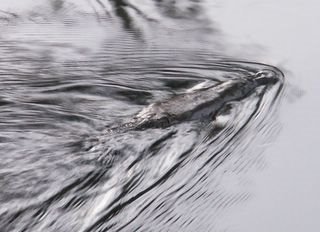
Eungella is famous for platypus. Is the plural platypi or platypuses? Either way, we saw several. This was the best shot I could get of one (they're not all that accommodating for tourists with cameras, but they're cute all the same).

In the same river, the cockatoos were making one hell of a racket. It was evening and they were screeching in the trees and occasionally coming down for a drink.
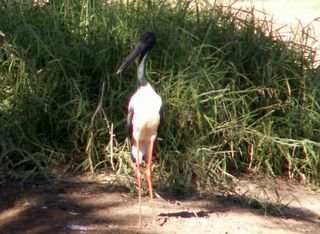
This jabiru was between Eungella and Collinsville (back in the dry country). The road, a shortcut, was a 4WD track and the bird was standing by one of the few waterholes in the area. Around here there were a lot of parrots too, but they were too fast for me to take a decent picture of them!!

Charters Towers. This building is now a cinema but was once a bank. Famous for a murder that occurred there in the early 1900s. The (very simplified) story goes that the manager of the bank had his pay cut and no-one was willing to tell him why, so he shot the chairman of the board. There is a room upstairs (not open to visitors unless you ask to see it) with a painting of the scene. The real attraction, though, is the table that all the board members were sitting around at the time. It still has a blood stain in the wood where the victim fell. I took a picture of it, though I'm not sure whether to believe that the stain is actually blood or not.
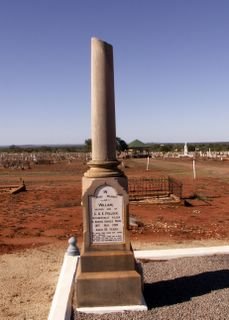
Charters Towers cemetery. This town is renowned for gold and at one time was about ten times the size that it is now (maybe not ten times, but it was much bigger - that's a fact - and ten times bigger sounds impressive). There were (and still are) many mines around the area. If a miner was killed in a mining accident, his headstone would look as though it had a corner taken from it to indicate it was a life cut short. It took a while for us to find these headstones, but once we found one, we saw many of them. This was a grave of a father and son - the son died several years before the father. They both died in mining accidents. The wife/mother died soon after the father.
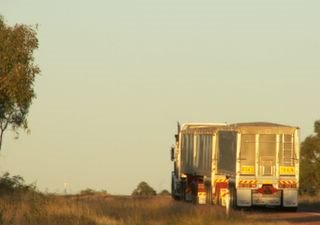
On the way to Belyando Crossing - a town that consists of a roadhouse and a tennis court. And is the only place of significance for at least 100 kilometres. For much of the way the highway is one lane. And the road trains don't get out of your way if they approach - they only show a small courtesy to other road trains. This was one that we were following for ages. It was pretty small - only three carriages (not sure if that is what they are actually called). The biggest I saw had five carriages!!

The last of the sunset (and a power line) at Belyando Crossing.

A very bold bird. Not sure what type. Maybe a wattle bird? Whatever he was, he wanted my cup of tea!!
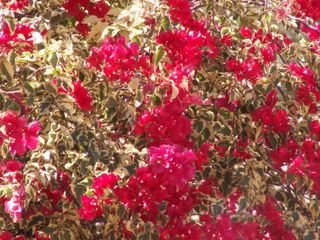
Bougainvillea. Just coz I thought it looked nice.

Eungella Dam. The dam is down to about 12% capacity. We drove down to the bottom of it, where I took this picture - my guess is it should be about 20 metres above it's current level.

The view from Eungella Historic Chalet. I am in the picture, sitting on the hang gliding ramp. Which, surprisingly, hasn't been used much since a girl jumped off and died about a year ago. I can only assume she was wearing the appropriate gear. The view from this place was stunning. It was, however, freezing!!!!! It was very rustic (read: no insulation, so very cold rooms and a whisper could be heard in the next room) but was nice to stay at once the wood fire was roaring and the red wine was flowing. Eungella is in the rainforest and is lush dairy farming country (or it was until deregulation forced most dairy farmers in the area out of business). Over the ridge there is very little rain (and is where the dam with no water is (above)).

Eungella is famous for platypus. Is the plural platypi or platypuses? Either way, we saw several. This was the best shot I could get of one (they're not all that accommodating for tourists with cameras, but they're cute all the same).

In the same river, the cockatoos were making one hell of a racket. It was evening and they were screeching in the trees and occasionally coming down for a drink.

This jabiru was between Eungella and Collinsville (back in the dry country). The road, a shortcut, was a 4WD track and the bird was standing by one of the few waterholes in the area. Around here there were a lot of parrots too, but they were too fast for me to take a decent picture of them!!

Charters Towers. This building is now a cinema but was once a bank. Famous for a murder that occurred there in the early 1900s. The (very simplified) story goes that the manager of the bank had his pay cut and no-one was willing to tell him why, so he shot the chairman of the board. There is a room upstairs (not open to visitors unless you ask to see it) with a painting of the scene. The real attraction, though, is the table that all the board members were sitting around at the time. It still has a blood stain in the wood where the victim fell. I took a picture of it, though I'm not sure whether to believe that the stain is actually blood or not.

Charters Towers cemetery. This town is renowned for gold and at one time was about ten times the size that it is now (maybe not ten times, but it was much bigger - that's a fact - and ten times bigger sounds impressive). There were (and still are) many mines around the area. If a miner was killed in a mining accident, his headstone would look as though it had a corner taken from it to indicate it was a life cut short. It took a while for us to find these headstones, but once we found one, we saw many of them. This was a grave of a father and son - the son died several years before the father. They both died in mining accidents. The wife/mother died soon after the father.

On the way to Belyando Crossing - a town that consists of a roadhouse and a tennis court. And is the only place of significance for at least 100 kilometres. For much of the way the highway is one lane. And the road trains don't get out of your way if they approach - they only show a small courtesy to other road trains. This was one that we were following for ages. It was pretty small - only three carriages (not sure if that is what they are actually called). The biggest I saw had five carriages!!

The last of the sunset (and a power line) at Belyando Crossing.

A very bold bird. Not sure what type. Maybe a wattle bird? Whatever he was, he wanted my cup of tea!!

Bougainvillea. Just coz I thought it looked nice.


12 Comments:
They are such fantastic photos!
My brother is currently residing just outside Charters Towers.
Very interesting photos. Sounds like you had a great time, especially with the camera.
I enjoyed my visit to Burdekin...(smile).
I enlarged the picture of Eungella and saw you on that hang gliding ramp and that was interesting about the minors head stones and a corner cut out if they died accidently in a mining accident.
You really posted some interesting pictures and I guess the platypus would be very difficult to photograph...much harder than the birds...at least they will stand somewhat still.
It's interesting that you call Semi's "road trains." We call them "semi's", or "tractor trailer trucks" (which this one makes no sense to me since they don't haul tractors). Some people call them "transfer trucks."
These are some great pictures! You brought back lots of memories for me of my trip across QLD way back before I was married. My friend, Barbara, and I rode on a road train for a while. It was one of the best parts of the trip. We stayed overnight in Charters Towers, I think. That old building is beautiful. I wonder is the guy got his pay reinstated after the murder :) That's the way to get things done...no fooling around!
Love that nosy bird, especially his bald spot around the eye...it's a good look for him :)
That photo with the cockies is really lovely. Love that bougenvillia with the variagated leaf...interesting. Well, I could chat for hours, but gotta run! This has been a very thought-provoking post!
Bye for now....enjoy your cup of tea :)
Sandy- big trucks are called semis here as well, particularly around the coast when it's just the cabin and the trailer. But in the outback, where distances are huge, there are several trailers attached and they virtually are trains. They all have signs on the front and back saying road train - warning people to think twice before passing them.
It's pretty hair-raising passing a semi! We used to drive between Mount Isa and Townsville regularly, and overnight in Charters Towers with My husband's sister. You pictures sure brought back memories. I liked CT, it has the outback feel without the isolation. Your platypus photo was beautiful :)
Emma
Tanya...I understand now why you call them road trains...thanks for the explanation.
Most of our semi's only have the truck and trailer, but on occasion we see some semi's with three trailers. I'm going to take notice to see if perhaps these trucks have "road train" printed on the back.
I feel like I've just been in the outback, your photos are so great, Tanya. I did think the platypus was a croc though, until I read your text.
You must have had some scary driving moments with those big trucks looming.
The photos really bring it home to me how different your part of the world is from England. A really excellent series of photos that capture the feeling of the place. Blogging shrinks the world, but it can point up the differences too.
I wonder how your Uncle Geoffrey would have liked driving one of those road trains? Gosh, he'd have been home before the rest of his truck had left the market!!
Tanya - after consulting a couple of voluminous bird books, your father says that bird is a "Blue-faced Honeyeater" found in Northern & Eastern Ausralia. Usually in pairs of small flocks, inhabiting open forest country.
The Blue-faced Honeyeater is probably in Tea Drinkers Anonymous. You did him a favor, I'm sure. :)
Post a Comment
<< Home